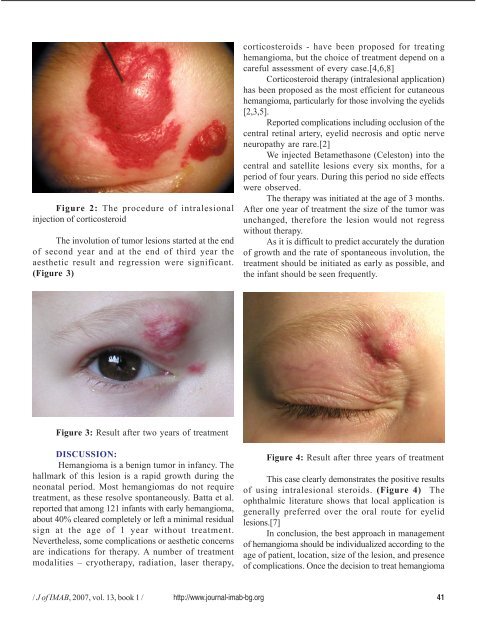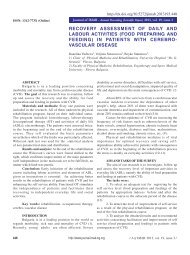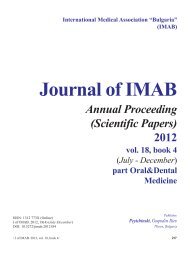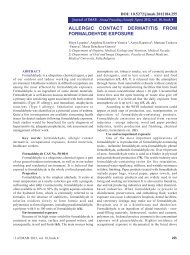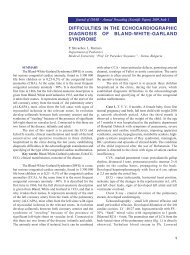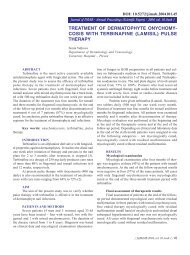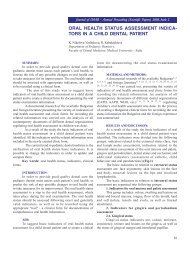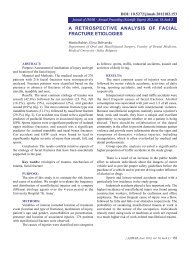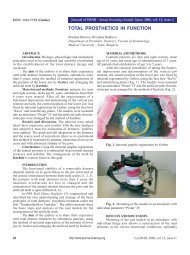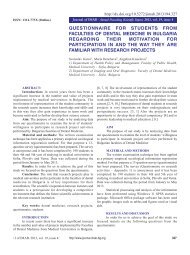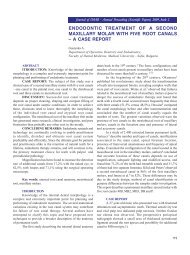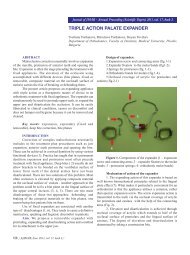conservative treatment of cavernous hemangioma ... - Journal of IMAB
conservative treatment of cavernous hemangioma ... - Journal of IMAB
conservative treatment of cavernous hemangioma ... - Journal of IMAB
You also want an ePaper? Increase the reach of your titles
YUMPU automatically turns print PDFs into web optimized ePapers that Google loves.
Figure 2: The procedure <strong>of</strong> intralesionalinjection <strong>of</strong> corticosteroidThe involution <strong>of</strong> tumor lesions started at the end<strong>of</strong> second year and at the end <strong>of</strong> third year theaesthetic result and regression were significant.(Figure 3)corticosteroids - have been proposed for treating<strong>hemangioma</strong>, but the choice <strong>of</strong> <strong>treatment</strong> depend on acareful assessment <strong>of</strong> every case.[4,6,8]Corticosteroid therapy (intralesional application)has been proposed as the most efficient for cutaneous<strong>hemangioma</strong>, particularly for those involving the eyelids[2,3,5].Reported complications including occlusion <strong>of</strong> thecentral retinal artery, eyelid necrosis and optic nerveneuropathy are rare.[2]We injected Betamethasone (Celeston) into thecentral and satellite lesions every six months, for aperiod <strong>of</strong> four years. During this period no side effectswere observed.The therapy was initiated at the age <strong>of</strong> 3 months.After one year <strong>of</strong> <strong>treatment</strong> the size <strong>of</strong> the tumor wasunchanged, therefore the lesion would not regresswithout therapy.As it is difficult to predict accurately the duration<strong>of</strong> growth and the rate <strong>of</strong> spontaneous involution, the<strong>treatment</strong> should be initiated as early as possible, andthe infant should be seen frequently.Figure 3: Result after two years <strong>of</strong> <strong>treatment</strong>DISCUSSION:Hemangioma is a benign tumor in infancy. Thehallmark <strong>of</strong> this lesion is a rapid growth during theneonatal period. Most <strong>hemangioma</strong>s do not require<strong>treatment</strong>, as these resolve spontaneously. Batta et al.reported that among 121 infants with early <strong>hemangioma</strong>,about 40% cleared completely or left a minimal residualsign at the age <strong>of</strong> 1 year without <strong>treatment</strong>.Nevertheless, some complications or aesthetic concernsare indications for therapy. A number <strong>of</strong> <strong>treatment</strong>modalities – cryotherapy, radiation, laser therapy,Figure 4: Result after three years <strong>of</strong> <strong>treatment</strong>This case clearly demonstrates the positive results<strong>of</strong> using intralesional steroids. (Figure 4) Theophthalmic literature shows that local application isgenerally preferred over the oral route for eyelidlesions.[7]In conclusion, the best approach in management<strong>of</strong> <strong>hemangioma</strong> should be individualized according to theage <strong>of</strong> patient, location, size <strong>of</strong> the lesion, and presence<strong>of</strong> complications. Once the decision to treat <strong>hemangioma</strong>/ J <strong>of</strong> <strong>IMAB</strong>, 2007, vol. 13, book 1 / http://www.journal-imab-bg.org 41


